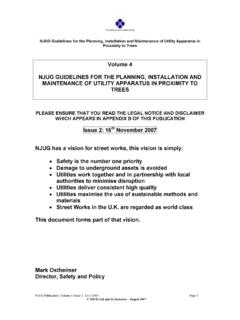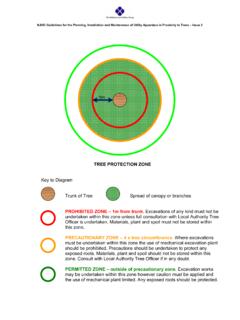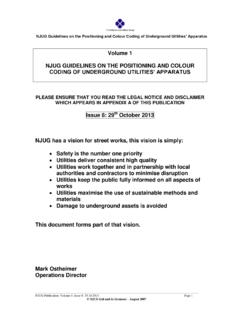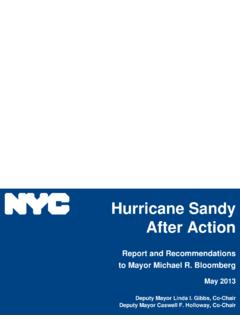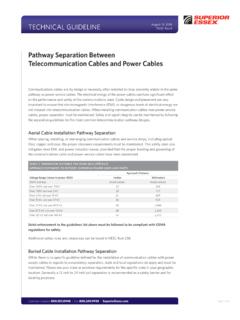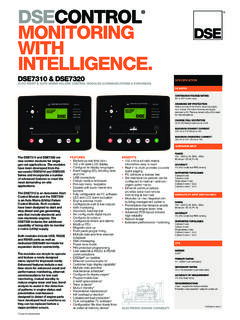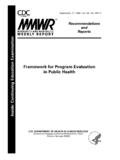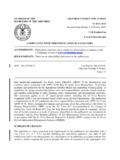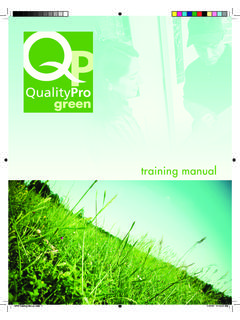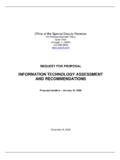Transcription of PLEASE ENSURE THAT YOU READ THE LEGAL …
1 NJUG Guidelines on the Positioning and Colour Coding of Underground Utilities Apparatus NJUG Publication: Volume 1: Issue 8: Page 1 NJUG Ltd and its licensors August 2007 Volume 1 NJUG GUIDELINES ON THE POSITIONING AND COLOUR CODING OF UNDERGROUND UTILITIES APPARATUS PLEASE ENSURE THAT YOU READ THE LEGAL NOTICE AND DISCLAIMER WHICH APPEARS IN APPENDIX A OF THIS PUBLICATION Issue 8: 29th October 2013 NJUG has a vision for street works, this vision is simply: Safety is the number one priority Utilities deliver consistent high quality Utilities work together and in partnership with local authorities and contractors to minimise disruption Utilities keep the public fully informed on all aspects of works Utilities maximise the use of sustainable methods and materials Damage to underground assets is avoided This document forms part of that vision.
2 Mark Ostheimer Operations Director NJUG Guidelines on the Positioning and Colour Coding of Underground Utilities Apparatus NJUG Publication: Volume 1: Issue 8: Page 2 NJUG Ltd and its licensors August 2007 The following volumes constitute the NJUG Publications. They are living documents and may be amended from time to time. There is no attempt to describe any specific industry process as each utility has its own specifications and procedures. Not all the publications will necessarily be available at one time as individual volumes will be published when available.
3 NJUG PUBLICATIONS Current Previous VOLUME 1 NJUG Guidelines on the Positioning and Colour Coding of Underground Utilities Apparatus NJUG 4 & 7 VOLUME 2 NJUG Guidelines on the Positioning of Underground Utilities Apparatus for New Development Sites NJUG 2, 5 & 6 VOLUME 3 NJUG Guidelines on the Management of Third Party Cable Ducting New VOLUME 4 NJUG Guidelines for the Planning, Installation and Maintenance of Utility Apparatus in Proximity to Trees NJUG 10 VOLUME 5 NJUG On-Site Environmental Good Practice Guidelines New VOLUME 6 NJUG Guidelines on Co-ordination, Co-operation and Communication New The following NJUG publications have not been reviewed and have been completely withdrawn.
4 NJUG 3 Cable Locating Devices NJUG 8 Performance Guide for the Assessment of Metallic Pipe and Cable Locators NJUG 9 Recommendations for the Exchange of Records of Apparatus between Utilities NJUG 11 Proposed Data Exchange Format for Utility Map Data NJUG 12 NJUG Specification for the Digitisation of Large Scale OS Maps NJUG 13 Quality Control Procedure for Large Scale OS Maps Digitised to OS 1988 NJUG 15 NJUG/Ordnance Survey Service Level Agreement (Technical) for Digital Map Products and Services NJUG Guidelines on the Positioning and Colour Coding of Underground Utilities Apparatus NJUG Publication: Volume 1: Issue 8: Page 3 NJUG Ltd and its licensors August 2007 CONTENTS Background 5 Scope 5 1.
5 IDENTIFICATION 6 Pipe / Duct Identification and Recommended Depths 6 Colour 9 Marker / Warning Systems 10 2. POSITIONING OF APPARATUS IN A TWO METRE WIDE FOOTWAY 10 3. INSTALLING APPARATUS IN THE CARRIAGEWAY 12 Specification for the Reinstatement of Openings in Highways code of practice (SROH) 12 Ducts 12 Motorways 13 4. INSTALLING APPARATUS OFF THE PUBLIC HIGHWAY 13 Electricity 13 Water and Waste Water 13 Communications 14 Gas 14 5. FACTORS INFLUENCING THE POSITION OF UNDERGROUND APPARATUS 14 6.
6 TRENCH SHARING 15 7. COMBINED SERVICE DUCTS, SUBWAYS AND TUNNELS 16 8. USE OF ABANDONED AND SURPLUS APPARATUS 16 9. DISTRICT HEATING 16 TABLE 1 Recommended Colour Coding of Underground Utilities Apparatus 7 TABLE 2 Recommended Colour Coding of Other Underground Apparatus 8 FIGURE 1 Recommended Positioning of Utility Apparatus in a 2 metre footway 11 NJUG Guidelines on the Positioning and Colour Coding of Underground Utilities Apparatus NJUG Publication: Volume 1: Issue 8: Page 4 NJUG Ltd and its licensors August 2007 GLOSSARY 17 APPENDIX A Important LEGAL Notice and Disclaimer 19 NJUG Guidelines on the Positioning and Colour Coding of Underground Utilities Apparatus NJUG Publication: Volume 1: Issue 8: Page 5 NJUG Ltd and its licensors August 2007 These guidelines describe utility industry practice.
7 However, it should not be assumed that all mains or services will conform to the recommendations for positioning or colour coding contained in this publication. This volume supersedes NJUG 4 The Identification of Small Buried Mains and Services , NJUG 7 Recommended Positioning of Utilities Apparatus for New Works on New Developments and in Existing Streets and the NJUG revision Utilities Guidelines on the Positioning and Colour Coding of Apparatus . Background The statutory right of undertakers (utilities) to carry out works within the public highway in order to provide and maintain their apparatus dates from the mid-19th century.
8 There are no statutory obligations governing the position or depth at which apparatus should be laid within the highway. The following guidelines should therefore be adhered to wherever practicable. The New Roads and Street Works Act 1991, as amended by the Transport Act 2000, the Traffic Management Act 2004, the Transport (Scotland) Act 2005 together with the Street Works (Northern Ireland) Order 1995, sets down the legislative requirements to be adopted during the installation, repair and maintenance of apparatus in roads and streets. Scope (i) Utility apparatus can be vulnerable to damage from works carried out in the highway.
9 The safety of operatives and the public is of paramount importance. It is therefore in the interests of all parties to make every effort to minimise both the occurrence and effect of damage (see Volume 3). (ii) Early consultation between highway authorities, planners, architects, developers and utilities is important to ENSURE that engineering and planning requirements for the installation of infrastructure are agreed. (iii) These guidelines apply to utility apparatus placed beneath: a) Footways b) Carriageways c) Cycle tracks d) Verges e) Service strips f) Footpaths NJUG Guidelines on the Positioning and Colour Coding of Underground Utilities Apparatus NJUG Publication: Volume 1: Issue 8: Page 6 NJUG Ltd and its licensors August 2007 (iv) These recommendations are based upon a two metre wide footway, which is the minimum width required to accommodate the full range of utility services.
10 Due to the complexity of layout and size of utility and other apparatus only guidance can be given on their actual positioning. However, utilities and others should always endeavour to comply with the recommended positioning of their apparatus. (v) In the case of innovative street designs, such as Home Zones, the emphasis must be on early consultation between all involved to ENSURE that the utility services are positioned so as to allow safe access for maintenance and repair. (vi) On new development sites where utility apparatus is installed by the Developer or a third party, the guidelines contained within this section for the positioning and colour coding of underground apparatus should be followed.
